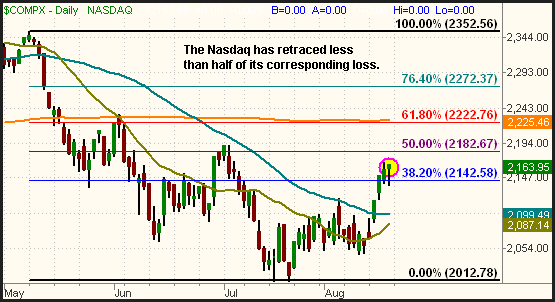The major indices fell modestly during the first thirty minutes of last Friday's session, but reversed and drifted higher throughout the rest of the session. By day's end, the broad market had managed to shake off early losses and mount its fifth straight day of gains. Both the S&P 500 and Dow Jones Industrial Average gained 0.3%, but the Nasdaq Composite showed relative weakness this time and advanced only 0.3%. Dell Computer, which opened 9% lower due to a disappointing earnings report, weighed on the tech sectors. The small-cap Russell 2000 eked out a gain of 0.1%, while the S&P Midcap 400 finished 0.2% higher. Stocks finished near their best levels of the session, but strong or weak action into the close is often deceiving on options expiration days.
Total volume in the NYSE declined by 12%, and was 11% lower than the previous day's level in the Nasdaq. The broad market has rallied in each of the past two sessions, but turnover declined on both days. Once again, volume in both exchanges also came in below average levels. Nevertheless, market internals confirmed the bullish price action by reversing from negative territory. In the Nasdaq, declining volume was outpacing advancing volume by 3 to 1 after the first half hour of trading, but the ratio reversed to finish in marginally positive territory. Advancing volume exceeded declining volume by more than 3 to 2 in the NYSE.
The S&P 500 gained 2.8% last week, but the Nasdaq zoomed 5.1% higher. Strength in the Semiconductor Index ($SOX), always a sector that is capable of moving the entire stock market, was largely responsible for sparking the whole rally. The $SOX gained more than 10% for the week. Based purely on the difference in last week's price gains, one may conclude that the Nasdaq presents the most favorable odds for profitability right now. However, don't forget the big picture of what has happened since the broad-based selloff began on May 10. Prior to last week, the Nasdaq was showing major relative weakness to both the S&P and Dow for many weeks. Each decline in the S&P was exceeded by the Nasdaq, while the Nasdaq failed to match the gains of nearly every S&P bounce. The end result was that a lot more overhead supply was created in the Nasdaq than in the S&P and Dow. The S&P 500 has recovered seventy-five percent of the loss from its May high down to its June low, but, reg! ardless of last weeks 5.1% gain, the Nasdaq Composite has still made up less than half of its corresponding loss. To illustrate this, compare the daily charts of the S&P and Nasdaq below. Fibonacci retracement lines have been drawn so that you can easily spot the Nasdaq's relative weakness:


As you can see, the S&P 500 clearly has less overhead resistance than the Nasdaq, especially if you consider that the Nasdaq still remains below its 200-day moving average. In the "big picture," it would appear that you're still better off buying stocks and ETFs in the "old economy" S&P and Dow sectors as opposed to the tech sectors. However, those S&P and Dow-related sectors have now begun to show relative weakness while the $SOX leads a Nasdaq recovery. With the Nasdaq presently showing the most relative-strength in the short-term, but the S&P presenting a healthier intermediate-term chart, what's a smart trader to do? We suggest you take a step away from the broad-based ETFs such as SPY or QQQQ, and instead focus your efforts on the individual sector ETFs that are showing the most relative strength or weakness. We discussed which sectors we like best throughout last week's commentary, but here is a refresher. Sectors with relative strength: Semiconductors (and m! ost other tech sectors), Utilities, and Pharmaceuticals. Sectors with relative weakness: Oil, Gold, Financials (especially the brokers), Real Estate (REITs), and Transportation. Check out our free ETF Roundup guide for a list of which ETF ticker symbols correspond to those sectors.
Because many traders and investors take a vacation in the month of August, market activity has been slow beneath the surface. The S&P 500, for example, has closed higher in each of the past five sessions, but volume has only exceeded its 50-day average level in one of the past ten days. This begs the question of whether or not market sentiment will remain the same when institutional activity returns to the scene, most likely after the Labor Day holiday. One certainly can not deny that the stock market's price action alone was rather positive last week, but astute traders know that volume is the lifeblood of the market's health. Because institutions are responsible for more than fifty percent of the shares that trade hands on an average day, stocks will always mirror the overall bias of mutual, hedge, and pension funds. It's okay to ride the momentum of the market's recent strength, but consider using tight trailing stops to protect your gains or minimize losses! on any late-stage long entries.
Deron Wagner is the Founder and Head Trader of both Morpheus Capital LP, a U.S. hedge fund, and Morpheus Trading Group, a trader education firm launched in 2001 that provides daily technical analysis of the leading ETFs and stocks. For a free trial to the full version of The Wagner Daily or to learn about Wagner's other services, visit MorpheusTrading.com or send an e-mail to deron@morpheustrading.com.